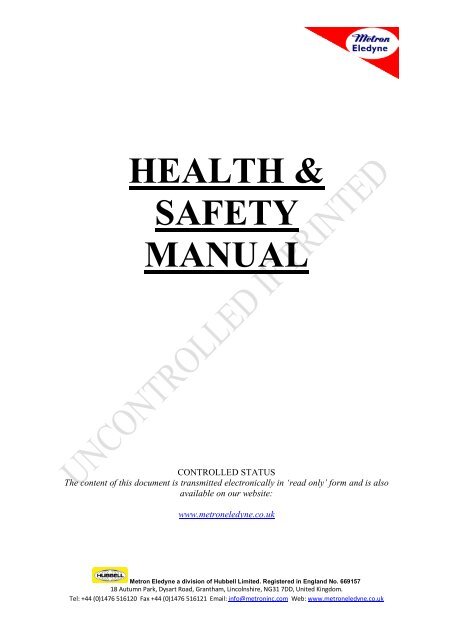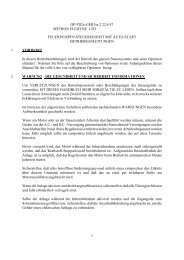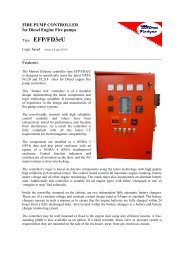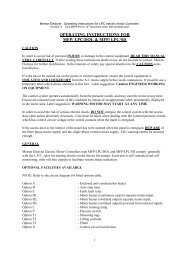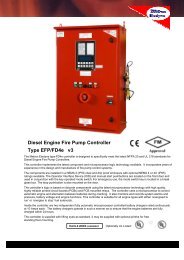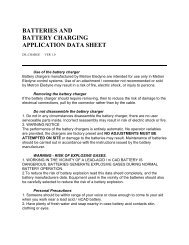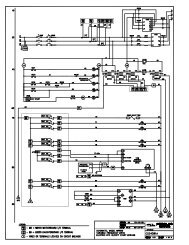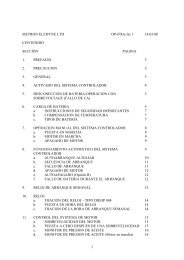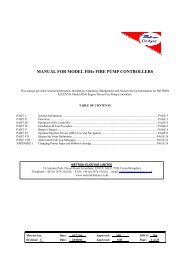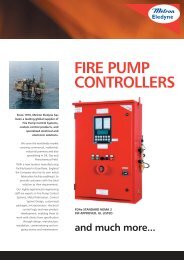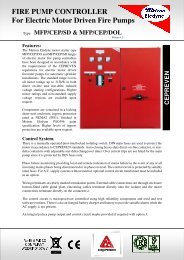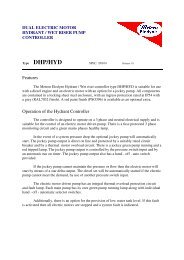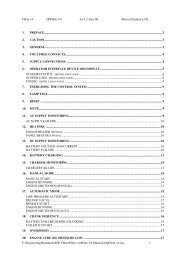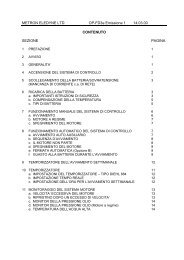HEALTH & SAFETY MANUAL - Metron Eledyne
HEALTH & SAFETY MANUAL - Metron Eledyne
HEALTH & SAFETY MANUAL - Metron Eledyne
Create successful ePaper yourself
Turn your PDF publications into a flip-book with our unique Google optimized e-Paper software.
<strong>HEALTH</strong> &<br />
<strong>SAFETY</strong><br />
<strong>MANUAL</strong><br />
CONTROLLED STATUS<br />
The content of this document is transmitted electronically in ‘read only’ form and is also<br />
available on our website:<br />
www.metroneledyne.co.uk<br />
<strong>Metron</strong> <strong>Eledyne</strong> a division of Hubbell Limited. Registered in England No. 669157<br />
18 Autumn Park, Dysart Road, Grantham, Lincolnshire, NG31 7DD, United Kingdom.<br />
Tel: +44 (0)1476 516120 Fax +44 (0)1476 516121 Email: info@metroninc.com Web: www.metroneledyne.co.uk
CONTENTS<br />
PAGE 1. Statement of Intent<br />
2. Responsibilities<br />
3. Compliance<br />
4. External Support<br />
5. Meetings<br />
6. Awareness<br />
7. First-Aid<br />
8. Fire Precautions<br />
9. Monitoring<br />
10. COSHH<br />
11. Electrical Safety<br />
12. Mechanical Handling<br />
13. VDU’s<br />
14. Visitors<br />
15. Working at Height<br />
16. Company Vehicles/Driving<br />
17. Sitework<br />
18. Personal Protective Equipment<br />
APPENDICES<br />
Risk Assessment Methodology<br />
Safety Team Flowchart
RESPONSIBILITIES:<br />
2<br />
The Company is ultimately responsible for:<br />
The health and safety of all employees.<br />
The health and safety of visitors to the site.<br />
Implementation of the Health and Safety Policy.<br />
Managers and Supervisors are to organise their departments so that:<br />
The Company’s Health and Safety Policy and all relevant information issued<br />
by the Company is acted upon.<br />
Health and Safety responsibilities within their respective departments are<br />
properly assigned and fulfilled.<br />
Staff comply with this handbook and any other Health & Safety information<br />
supplied by the company, with special regard to safe working procedures<br />
and wearing of safety equipment provided.<br />
Each individual employee receives the appropriate Health &Safety<br />
information and training required for their specific job. Part of the training<br />
must include induction training and location of first aid treatment and fire<br />
exits.<br />
Accidents are fully investigated with a view to preventing any recurrences.<br />
Good housekeeping standards are maintained throughout the site.<br />
All new and existing equipment is periodically inspected and that there are<br />
procedures in place with reference to mechanical and operational safety.<br />
Employees must ensure that:-<br />
They co-operate with the company by fulfilling their legal responsibilities under<br />
Health & Safety Legislation. All relevant information issued through the Health<br />
and Safety Management System is to be acted upon.<br />
Employees must:<br />
Ensure that they are aware of the Health and Safety implications of their jobs<br />
and in particular are aware of the emergency evacuation procedure.<br />
Take reasonable care for the Health and Safety of themselves and any other<br />
people who may be affected by their acts or omissions.
Co-operate with employers and others to enable them to comply with statutory<br />
duties and requirements.<br />
Not intentionally or recklessly interfere with or misuse anything provided in<br />
the interests of health and safety.<br />
Use any dangerous substances, means of production and transport equipment<br />
in accordance with relevant training and instruction.<br />
Use equipment / safety devices provided to them by <strong>Metron</strong> <strong>Eledyne</strong> in<br />
accordance with any training given in the use of the equipment.<br />
Report any defective equipment / process to their Line Supervisor or team<br />
leader.<br />
Report anything they consider to be a possible danger, or any shortcomings in<br />
the arrangements for Health and Safety, to their immediate supervisor.<br />
At all times fully comply with Health and Safety Regulations. Any breach of<br />
Company standard Operating Procedures or Statutory Regulations may lead<br />
to disciplinary action being taken.
3<br />
COMPLIANCE:<br />
The Company will strive to comply with all relevant Health and Safety<br />
legislation. A full list of applicable legislation is held within the<br />
company’s quality system, Q-Pulse, and maintained by the groups<br />
Quality and Environmental Manager of actual legislation that the<br />
Company is subject to and other legal requirements to which it<br />
subscribes.
4<br />
EXTERNAL SUPPORT:<br />
In addition to the internal management team we use the resources of<br />
our parent company, Hubbell Ltd, to give added support on specific<br />
issues arising, and to conduct periodic audits to ensure compliance<br />
with legislation.<br />
We are registered with our local HSE office at:<br />
<strong>HEALTH</strong> & <strong>SAFETY</strong> EXECUTIVE<br />
CITY GATE WEST<br />
TOLLHOUSE HILL<br />
NOTTINGHAM
5<br />
MEETINGS.<br />
Management meetings are held on a quarterly basis at least, based on<br />
an agenda which includes Health & Safety and Environment. The<br />
purpose of this is to expose any issues which have arisen during the<br />
month and take action where necessary. All actions are logged and<br />
reviewed at the next meeting until fully resolved.<br />
The attendees are the usual Health, Safety & Environmental<br />
Management Team, with additional attendees dependant on specific<br />
issues as listed within the Agenda.<br />
Decisions arising from these meetings are conveyed to the personnel<br />
concerned by means of memo, verbally or in terms of updated<br />
procedures.<br />
Managers will make known any changes to processes which may have<br />
safety or environment implications.<br />
The minutes taken will form the basis of the following meeting thus<br />
ensuring continuity of aims and targets.
6<br />
GENERAL AWARENESS<br />
All new staff are given an induction which includes a full presentation<br />
on Health & Safety.<br />
This is backed up by specific training courses (where deemed<br />
beneficial), and by ‘on-the-job’ and ‘in-house’ training, all of which is<br />
held on the individuals training file.
7<br />
FIRST-AID<br />
We currently have the following trained ‘First Aider at Work’:<br />
Full 4 Day Cert Holders: Michael Dowse until 5.4.2013<br />
Robert Bowen until 8.10.2014<br />
An Accident Book is maintained and accidents are reported to the<br />
Quality/Safety Manager as soon as possible, who then, if necessary,<br />
reports to the HSE under the terms of RIDDOR.<br />
First-Aid boxes are maintained by the above trained personnel, in<br />
addition to eye-wash stations.<br />
Staff are encouraged to report “near-misses” to their respective<br />
managers or the Quality/Safety Manager, which will then be discussed<br />
at the management meetings and appropriate actions taken where<br />
necessary.
8<br />
FIRE PRECAUTIONS.<br />
All personnel are instructed on fire procedures during induction, and<br />
drills and alarm equipment testing is carried out on a regular basis and<br />
recorded.<br />
Extinguishers are positioned throughout the facility with regular<br />
maintenance being carried out by a specialist contractor.<br />
Fire roll-callers are appointed and Fire Marshals trained:<br />
Roll Callers:<br />
Martyn Fovargue (deputy)<br />
Mick Dowse (main)<br />
Steve Bennett (deputy)<br />
Fire Marshals: Matt Heard (rear office - deputy)<br />
Harry Garner (rear office)<br />
Rob Bowen (factory - deputy)<br />
Paul Foster (factory)<br />
Martin Freestone (front office - deputy)<br />
Andy Shaw (front office)<br />
A Fire Policy Statement is issued by the Managing Director annually to<br />
define company and employee responsibilities.<br />
Visitors have to sign in at reception and give vehicle details. They also<br />
receive a ‘Visitors Safety Information’ sheet.<br />
Staff are given training in extinguisher use when units are available for<br />
discharging.<br />
All exits routes are marked and signs and emergency lighting<br />
maintained.<br />
A risk assessment has been carried out which gives a LOW RISK<br />
category for the premises.
9<br />
MONITORING<br />
RISK ASSESSMENTS.<br />
The company carries out assessments of risks in all areas in line with<br />
the methodology chart in the appendices.<br />
These are reviewed every year or when there are changes in<br />
procedures or processes.<br />
HAZARDS ASSESSED CURRENTLY INCLUDE:<br />
SLIPS & TRIPS<br />
MACHINERY(MOVING PARTS)<br />
WORK ABOVE GROUND LEVEL<br />
PRESSURE SYSTEMS<br />
EJECTED MATERIALS<br />
ELECTRIC SHOCK<br />
VEHICLES<br />
DUST/FUMES<br />
NOISE<br />
<strong>MANUAL</strong> HANDLING<br />
LIGHTING<br />
DISPLAY SCREEN EQUIPMENT<br />
FIRE<br />
HAND & ARM VIBRATION<br />
CHEMICALS
10<br />
COSHH<br />
Assessments for any chemicals used on site are carried out and data<br />
sheets held by the first-aiders, with copies maintained by the Quality /<br />
Safety Manager.<br />
A separate set of data sheets are held for the chemicals used by the<br />
cleaning staff, and checked by the Quality / Safety Manager as part of<br />
the regular COSHH review.<br />
The following general guidance is applicable to most substances:<br />
- Always read the label on the container. Label any container that<br />
you fill with chemicals.<br />
- Wear the recommended protective equipment when working with<br />
chemicals.<br />
- Use safety equipment provided.<br />
- Follow safe working procedures when handling hazardous<br />
substances.<br />
- If in doubt ask your supervisor/team leader<br />
The company does not produce more than 500 kg of hazardous waste<br />
and are therefore no longer formally registered with the Environmental<br />
Agency as a disposer of hazardous waste.
11<br />
ELECTRICAL <strong>SAFETY</strong><br />
All portable appliances are PAT tested annually by a approved<br />
contractor and a record of results kept.<br />
All electrical supply circuits in the Test Department are protected by<br />
RCD earth leakage circuit breakers.<br />
All fixed plant/machinery is inspected regularly for electrical safety<br />
and logged on each assets Q Pulse record.<br />
Measuring instruments are checked during calibration by an external<br />
contractor.<br />
The factory installation wiring is inspected by a registered electrical<br />
contractor every three years.
12<br />
MECHANICAL/<strong>MANUAL</strong> HANDLING<br />
Correct Manual Handling can do a lot to prevent the strains and backache which accounts for<br />
a very high proportion of all industrial injuries. Once your back has been injured that<br />
weakness can remain with you for the rest of your life. You can avoid this type of injury by<br />
following these guidelines.<br />
- Assess the weight of the load and get help if it is beyond your capability. Where<br />
appropriate use the mechanical aids provided.<br />
- Size up the job - remove any obstructions; make sure there is a clear space where the<br />
load has to be set down. Ensure you can see over the load when carrying it.<br />
- Look for any splinters or sharp edges on the load.<br />
- Stand close to the object and with your feet 8-12 inches apart, one foot in front of the<br />
other, pointing in the direction you intend to move.<br />
- Put your chin in; avoid moving your head.<br />
- Bend your knees a crouch position, keeping your back straight.<br />
- Get a firm grip at opposite ends of the load and keep the load as close to your body as<br />
possible.<br />
- Lift the load with your thigh muscles by looking up and straightening your legs.<br />
Do Not<br />
- Change grip when carrying.<br />
- Twist your back while working<br />
- Carry on if you feel strain.<br />
- Stretch for loads.<br />
Company guidance for mechanical/manual handling is as follows:<br />
Single person lift no greater than 25KG*<br />
Dual person lift up to 50KG*<br />
Above 50KG – use of pallet truck<br />
Above 1000kg – use Fork Lift Truck (up to 1500KG)<br />
Above this specialist lifting equipment will be hired / contracted.<br />
*Dependant on the individual – if in doubt get help.<br />
Manual handling training is included in the induction of new staff.<br />
Lifting equipment is subject to Regulatory inspections, and certificates to cover this are<br />
retained within the Q Pulse Asset Register.<br />
CURRENT HOLDERS OF CERTIFICATES FOR FORK LIFT TRUCK DRIVING (and<br />
attachments):<br />
Paul Conner Martin Freestone Clive Bell<br />
Liam Shirtcliffe<br />
Michael Dowse<br />
Planning for unusual / abnormal loads is carried out by completion of the standard ‘Special<br />
Load ‘sheet.
13<br />
VISUAL DISPLAY UNITS<br />
The company ensures the all employees are assessed annually to<br />
prevent any adverse effects from the use of computer screens and fixed<br />
workstations. This covers all habitual users but not those who use them<br />
only for reference purposes. It does not include laptop users because of<br />
the variations in possible location/positions.<br />
The staff who undergo this assessment are entitled to the cost of eye<br />
tests and financial assistance towards the purchase of spectacles.<br />
Recommended periods of rest are specified at the induction.
14<br />
VISITORS<br />
The company takes the responsibility of visitors/contractors being on their site<br />
seriously and with this aim we:<br />
Provide a visitor registration book requesting details of name, company, person<br />
visited, car registration, date, and times.<br />
Safety information sheets are available in reception for new visitors:<br />
VISITOR <strong>SAFETY</strong> INFORMATION<br />
<strong>Metron</strong> <strong>Eledyne</strong> would kindly request visitors to our site comply with the following<br />
guidance in order to ensure effective control of the work areas and the safety of all personnel:<br />
1. Observe all Safety notices, warning signs and instructions you encounter when on this<br />
site<br />
2. Remain within the specific area of interest where you will be accompanied by <strong>Metron</strong><br />
<strong>Eledyne</strong> staff at all times.<br />
3. Areas enclosed by yellow markings should only be entered with safety shoes on or<br />
with management approval and production stopped as there is a risk of injury from<br />
dropped product or materials. Safety glasses must be worn when requested.<br />
4. When visiting the Test area, visitors must not touch any equipment without specific<br />
permission from our engineer and should observe the warning lights for voltages:<br />
Amber = 380 – 440v, Red = higher than 440v.<br />
5. Fork lift trucks operate within this factory and grounds. Take special care to look &<br />
listen for approaching vehicles, including in the car parks and at the rear and the side<br />
of the building.<br />
6. Smoking is not prohibited within the building and grounds. A smoking area is<br />
provided and the location can be shown on request.<br />
7. The fire alarm is a long continuous bell and tests are carried out weekly. A warning is<br />
provided via the public address system when these tests are being carried out. At any<br />
other time you should assume the alarm is real and evacuate the building in a safe<br />
manner via the nearest exit. Follow your guide or other <strong>Metron</strong> <strong>Eledyne</strong> staff and<br />
make your way to the assembly point at the bottom of the yard. The Fire Marshals<br />
will check via the visitors’ book and, as far as is safe in practice, ensure that no-one is<br />
still inside the building.<br />
8. Please register visitor and vehicle details on arrival and advise reception when leaving<br />
site.<br />
Contractors working in the factory area are requested to complete a risk<br />
assessment before commencing any significant work.
15<br />
WORKING AT HEIGHT<br />
The factory being all on one level does not represent a high risk in<br />
this category. No process work is above ground level.<br />
Ladders are used for maintenance purposes only. These are subject to<br />
regular inspection.<br />
The personnel cage used as an attachment to the FLT is used only by<br />
appropriately trained drivers when required, and is also subject to<br />
regular safety inspections.<br />
Small steps are used for assembly work on taller units, but these are<br />
self-setting airport types with handrails.
16<br />
COMPANY VEHICLES/DRIVERS<br />
Our procedure DP-01 sets out requirements for work-related driving:<br />
1. Before any journey it is the responsibility of the driver to check that the vehicle is in<br />
roadworthy condition and report any defects to Martyn Fovargue or David Carter.(If<br />
travelling abroad the driver must also ensure that the safety triangle, breathalyser kit<br />
(where required), spare bulbs, first-aid kit, fire extinguisher, reflective jacket and<br />
insurance documentation are carried). Before a long journey oil/water level and tyres<br />
should be checked.<br />
2. When planning journeys time must be allowed for breaks to avoid fatigue, traffic or<br />
weather conditions.<br />
3. Drivers should familiarise themselves with the procedure to follow in the event of a<br />
breakdown.<br />
4. Hand-held mobile phones will not be used while driving.<br />
5. Speed limits must be adhered to at all times.<br />
6. All vehicles are smoke-free zones.<br />
7. Any illness, injury or medication that may affect driving ability must be advised to the<br />
manager.<br />
8. Drivers must be familiar with the latest edition of the Highway Code/specific<br />
regulations applicable abroad.<br />
9. Drivers must have regular eye examinations and those over 65 may be requested to<br />
undergo a medical examination for fitness to drive.<br />
10. Company transport can only be used for private use with the permission of the<br />
Managing Director.<br />
(Rules 1 - 9 are also applicable to drivers of vehicles hired by the company)<br />
11. Driving hours will be limited to, or less than as defined in EC561/2006 Regulations<br />
(<strong>Metron</strong> <strong>Eledyne</strong> standard procedure DR-1).<br />
When using YOUR OWN vehicle on company business:<br />
1. The vehicle must be kept in roadworthy condition<br />
2. It must have a current MOT certificate (if applicable)<br />
3. The individual’s insurance must cover ‘business use’<br />
DOCUMENTATION<br />
All documents relating to company vehicles, including Registration Document, MOT (if<br />
app), insurance and servicing requirements/records are retained by the Quality / Safety<br />
Manager.<br />
Copies of all driving licences will be kept on file.<br />
Copies of insurance details for owner drivers will be kept on file.<br />
(It is the responsibility of any driver to advise of any changes to licences or insurance)<br />
This data will be collected annually.
17<br />
SITEWORK<br />
1) All personnel who regularly work on customer sites have taken<br />
certificated specialist training course as follows:<br />
UK Mainland Site Passport Scheme (CCSNG):<br />
Current until<br />
David Hemmings 06.01.2015<br />
Paul Foster 13.09.2014<br />
Josie McIvor 20.03.2015<br />
Offshore (PETANS) course:<br />
Bruce Murby 02.08.2013<br />
David Hemmings 09.03.2014<br />
2) All customer site visits are subject to a Pre-visit Assessment and<br />
are subject to the Safe System of Work for Engineer Customer<br />
Visits.<br />
This includes occasional ‘ad-hoc’ site visits conducted by other<br />
staff members who have taken the appropriate training and are<br />
deemed competent as shown on their individual training records.
18<br />
PERSONAL PROTECTIVE EQUIPMENT (PPE).<br />
All personnel are assessed for any protective clothing or equipment<br />
that may be necessary in order to carry out their work without causing<br />
a hazard their health. All staff are required to use PPE supplied to<br />
ensure their safety.<br />
If we cannot remove or reduce the hazard to permissible levels then<br />
specific equipment will be supplied.<br />
Protective eyewear and ear-plugs are freely available at entrances to<br />
the work area.<br />
Face masks, gloves, overalls and footwear are provided where<br />
necessary.<br />
hsem-ppe
APPENDICES
RISK ASSESSMENT<br />
METHODOLOGY<br />
DEFINE AREAS<br />
IDENTIFY HAZARDS<br />
IN THOSE AREAS<br />
DEFINE LEVEL OF<br />
RISK<br />
PRIORITISE<br />
HAZARD ANALYSIS<br />
ACTION PLAN<br />
REVIEW
METRON ELEDYNE<br />
<strong>HEALTH</strong> AND <strong>SAFETY</strong><br />
MANAGEMENT TEAM<br />
DAVID CARTER<br />
Managing Director<br />
MARTYN FOVARGUE<br />
Quality / Health & Safety /<br />
Environmental<br />
RAYMOND KNOX<br />
Hubbell Ltd<br />
MARTIN FREESTONE<br />
Operations<br />
Manager<br />
WAYNE<br />
RICHARDSON<br />
Engineering Manager<br />
ROB BOWEN<br />
Production supervisor<br />
PAUL FOSTER<br />
Production supervisor<br />
MICK DOWSE<br />
Metal Fabrication


